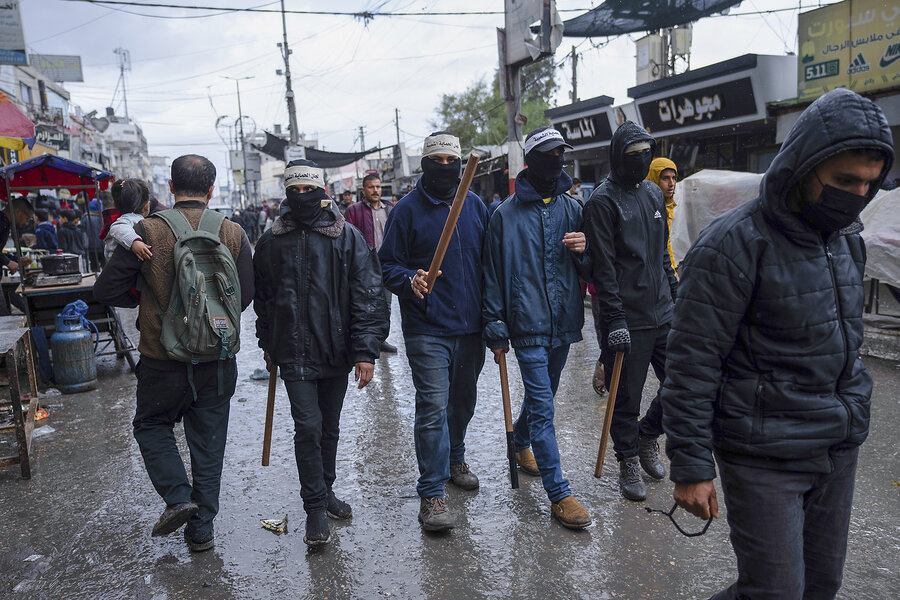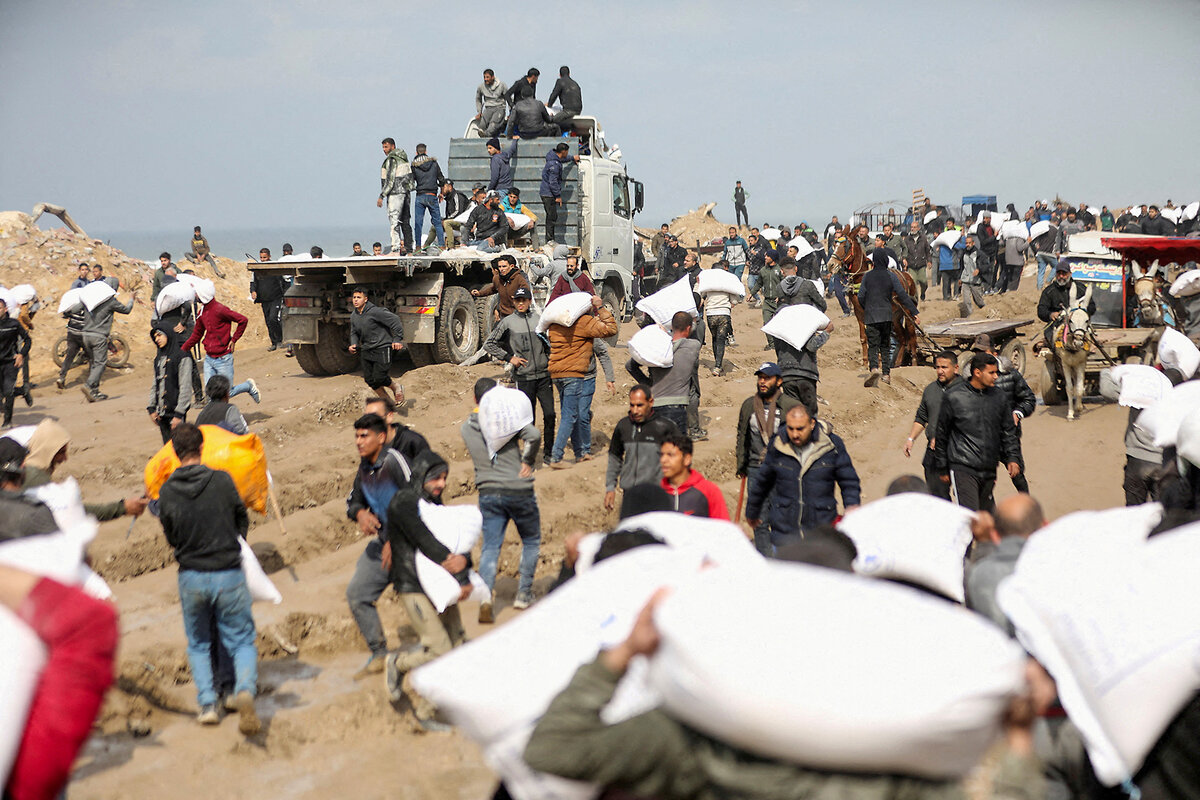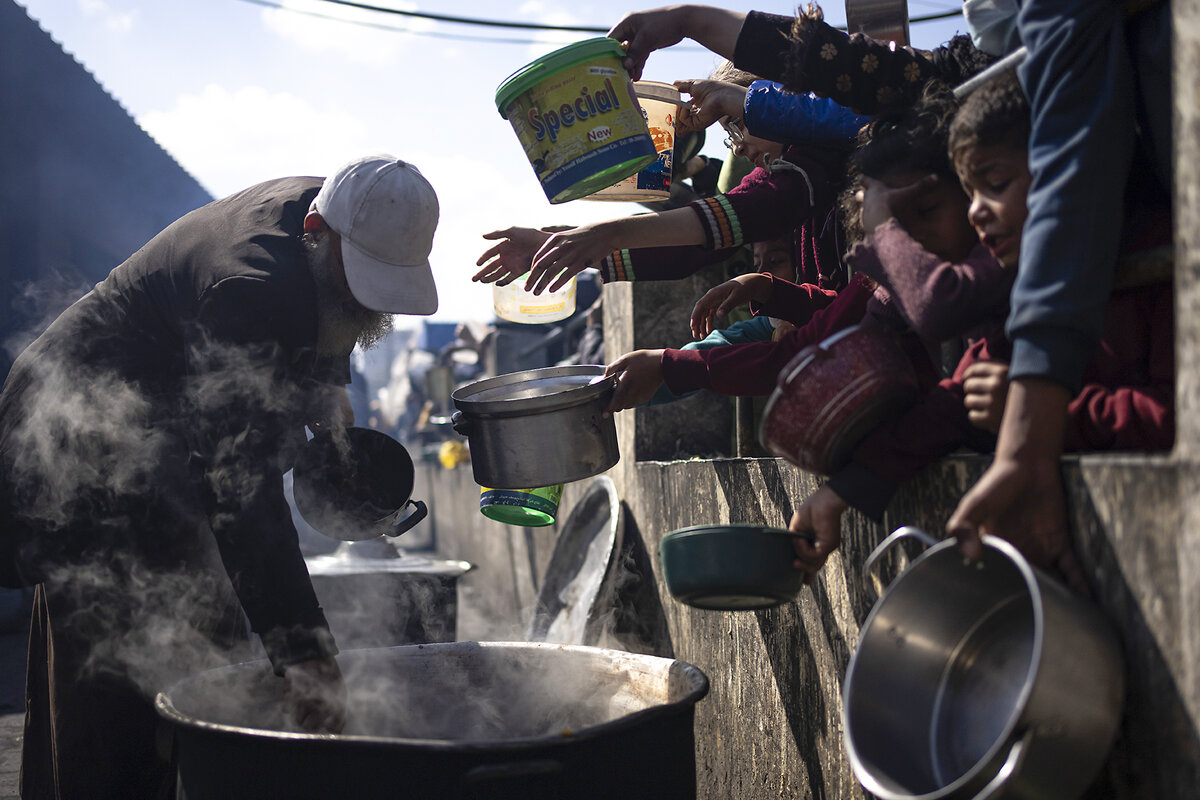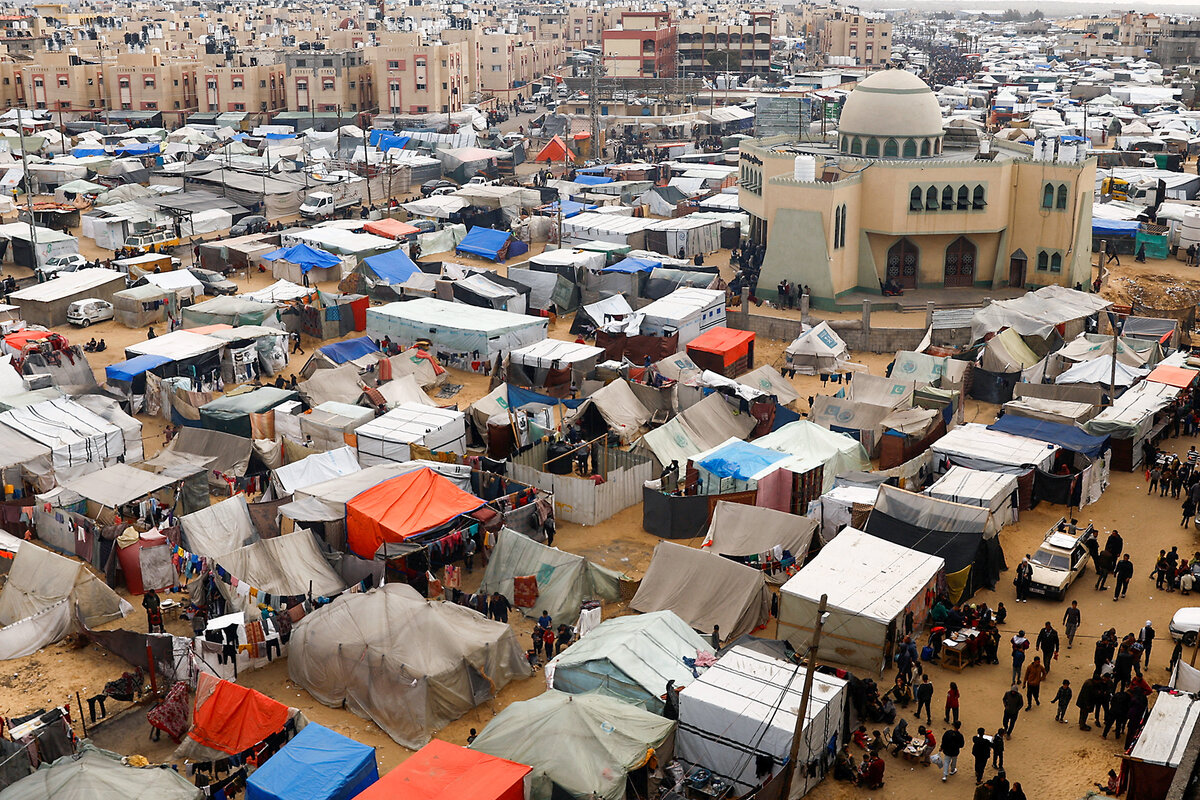‘Hamas gambled with our lives’: Gazans are now daring to speak out
Loading...
| AMMAN, Jordan; RAMALLAH, West Bank; and GAZA
Across the Gaza Strip – from markets to evacuee camps to social media channels – Palestinian frustration and anger with Hamas is on the rise.
Complaints began with Hamas’ apparent disregard for Gaza civilians who faced the brunt of Israel’s punishing military response to the Oct. 7 attack while Hamas fighters remained in tunnels.
Now, with starvation, profiteering, and internal chaos on the rise, the militant group that has ruled the strip for 17 years is nowhere to be found.
Why We Wrote This
A story focused onFor the first time since the war began in Gaza, resentment against Hamas is boiling to the surface in public expressions of anger and in social media, as residents increasingly are losing their reluctance to speak out.
“We did not choose to be in a war that takes us from our homes, [takes] the lives of loved ones, and puts our lives in a death game that we knew nothing about,” says Bisan Nateel, a youth organizer for a local Gaza nongovernmental organization.
“Hamas didn’t warn us or give any instructions to protect or help people. I don’t know what they were thinking or what they expected people to do, but this is unacceptable for everyone in Gaza,” says Walid, an aid worker in central Gaza who declined to use his full name. “I feel that Hamas gambled with our lives at stake, and lost.”
Rafaat Naim, a Gaza businessman and former member of the Palestine Chamber of Commerce, says prior to the war, support for Hamas among Gaza residents was already limited. “Hamas’ popularity in the Gaza Strip was waning, due to its governance failures [and] misallocation of funds,” he says. “The devastating impact of the conflict further entrenched this sentiment.”
The anger that has been simmering since the early days of the war, meanwhile, has only in recent weeks come to the surface. These are not organized calls or political protests against Hamas, but conversational complaints growing louder by the day. Tiny protests have been scattered.
“People now are very angry with Hamas, but at the same time they are afraid to express the anger inside them by protesting or holding sit-ins,” notes Wael Mohammad, a civil engineer and longtime Hamas critic in Gaza. He says 16 years of the Islamic Hamas’ intimidation tactics, as well as its use of religious faith to push its ideology, made “the population in Gaza docile.”
Now with the lack of Hamas police officers on the streets, and a reduced threat of being dragged off by its security services, people in Gaza, facing starvation, are more emboldened to criticize the movement in public. Some even curse it.
This outspokenness, however, does not mean Gazans’ support, in principle, for armed resistance against the Israeli occupation has lessened. Nor has their view changed that the conflict is an Israeli war against the Palestinian people.
There remains a belief among most residents that, with a 17-year siege of Gaza, they have been punished for two decades by Israel, the international community, and the Palestinian Authority for Hamas’ presence, and that the movement has never had the chance to act as a normal government.
Yet growing disillusion with Hamas’ rule is impacting the group’s future prospects each day the war goes on, as residents see it as unresponsive, irresponsible, and lacking basic care for Gaza’s people.
Evading responsibility
All those interviewed stressed that Hamas left the Gaza public “in the dark” about its plans even after Israel’s counterattack began. Added to the lack of communication was a seeming lack of concern for civilians as Hamas forces retreated to their tunnels.
“Hamas followed the same old war plan and left the people to the mercy of Israelis,” says Walid, the aid worker.
“We gave in to Hamas for a long time, and we thought Hamas as a party would be prepared for the war after Oct. 7 as they claimed. But they were only ready to protect themselves,” says Rana Alsayed, a mother and feminist activist from Gaza City who was displaced four times by Israel’s offensives.
“This war is beyond Hamas’ capabilities,” says Ahmed, a Gaza photojournalist who blames intense targeting by Israel’s military for the movement’s inability to govern or protect its citizens. “It cannot help itself, let alone the people.”
For some Palestinians in Gaza, the war has cemented the idea of Hamas as a militant faction looking out only for itself rather than for the people it has governed since first being elected by a plurality in 2006. It has ruled unopposed since 2007, when it drove out its rival Fatah and seized the strip.
“They see their role is to fight Israelis and not to care for the people. But since Hamas took control of the Gaza Strip, they implicitly agreed to care for its people,” says Walid, who, like many, sees Hamas as “evading that responsibility.”
“At least provide enough food for the people to not die of hunger. Build shelters and safe places for the people to go to. Establish a form of civic protection and law enforcement to keep people in check,” the aid worker says.
“The Oct. 7 operation was nothing but a continuation of the series of political and military gambles that the movement has made since its inception, an operation that brought nothing but destruction, killing, displacement, and deportation of the residents of the Gaza Strip,” says Mr. Mohammad, the civil engineer.
He likens the movement to “a group of mercenaries and militias that do not rise to the level of a Palestinian movement” and don’t “care about Palestinian blood.”
He, and others, point to statements by Hamas’ leadership abroad at the onset of the war that it was the responsibility of the United Nations and the international community, not Hamas, to protect Gaza civilians.
Anger over aid, profiteering
With a breakdown of law and order, organized crime is increasing and aid is looted and sold on the secondary market before many can get it. And there is a growing belief that not only does Hamas bear responsibility for the looting and profiteering through its absence, but it also may be complicit or participating in it.
“We have to buy food that was sent to Gaza as aid. We hear lots of rumors that this aid was stolen under the eyes of Hamas, sometimes in complicity with people from the government,” says Walid.
Mohammed, an accountant and former government employee now in Rafah, says the links between Hamas and aid theft across Gaza are “clear.”
“We cannot provide definitive proof, but who has the guns? Who has the monopoly on force in Gaza? It’s Hamas. The work of organized criminal groups wouldn’t happen without their consent,” Mohammed says via WhatsApp messaging. “They are profiting politically and economically from our death and misery.”
Dissent is also growing in the local business community. Members say they have long chafed under Hamas’ restrictions, appropriation of incoming materials, corruption, and wars.
They have lost businesses, farms, and homes in this war – but also have found no entity to facilitate a return of trade or even the distribution of basic aid to stave off a famine.
Despite the rising anger, fear persists amid occasional reports of mosque imams or civil society organizers being dragged off and “disappeared” by Hamas for voicing public criticism. Protesters gathering in northern Gaza were shot at by armed men.
“At the grassroots level, Hamas persists in its oppression even amid these dire circumstances,” notes Mr. Naim, the businessman.
Alternatives emerging?
In the void left behind by Hamas, some Gazans are attempting to organize at the grassroots to provide services and a sense of order.
In Rafah, so-called Protection Committees – groups of local young men, dressed in matching black clothes and masks, armed with batons – are providing basic security to markets and public areas.
Mr. Naim is one of several local Gaza business owners and community leaders who are attempting to form a council to facilitate the entry and distribution of aid and goods.
They have set their sights on advocating for the border to open to resume a robust flow of aid and commerce into the besieged strip.
“The people demand resolute, clear, and strategic decisions to pave the way for stability,” says Mr. Naim.
Yet attempts by the people to organize and circumvent Hamas face steep obstacles – and danger.
This week, unverified reports emerged that Hamas executed a mukhtar, or local community leader, in northern Gaza, allegedly for coordinating with the Israeli military for a separate initiative to facilitate aid.
The incident appeared to confirm what Palestinians in Gaza already knew or believed: Any Israeli involvement would delegitimize and kill any alternative group providing services in Gaza.
“The occupation’s civil administration has engaged with some community leaders and members of the private sector,” notes Mr. Naim. “This initiative is both unacceptable and risky for all involved on the Palestinian side.”
While the majority of Palestinians in Gaza interviewed say they no longer want Hamas’ rule, a significant portion still support its existence as an armed movement. A lack of alternatives leaves Gazans unsure of their future.
“I still support Hamas as a liberation movement, but I am not satisfied with its uncalculated actions,” notes Ahmed, the photojournalist.
With the losses piling up for families in Gaza facing missile strikes, famine, and profiteering, more Gazans say the idea of trusting Hamas as rulers governing the strip again is unthinkable.
“I lost my mother, my husband lost half his family, and we lost our house. My children have known nothing but wars and escalations,” says Ms. Alsayed, the Gaza feminist.
“How can my children ever believe in Hamas, who are neither providing us with a bite to eat nor allowing anyone else to do so?”









